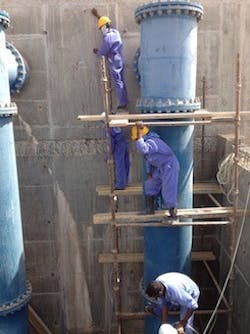Omani City Contends with Water Storage Challenge
Salalah is a coastal city in Oman, about 1,500 km south of Dubai. Although the beautiful city has an average population of 200,000, tourists flock there for its temperate summer climate. The city receives its water from a desalination plant that has the capacity to process 30 million gpd. This water then goes through a 105 km transmission line with DN 1200, DN 700 and DN 600 DI pipes into respective reservoirs that supply water to the residents as needed.
Addressing the issue
As the city and neighborhoods are expanding, additional transmission pipelines and a booster station have become needed to be able to efficiently fill reservoirs for a combined holding of 180,000 cum. Initially, city engineers considered installing float control valves on the reservoirs to control the water level, but altitude valves were more suitable for the application. Float valves in such large sizes would have been too slow and offered sluggish response.
Rajive Khosla, the Singer agent with Al Mutawaa Trading, recommended the city purchase and install 12 Singer altitude valves. These valves were to be installed on the inlet line to the reservoirs in chambers that would be easily serviceable at ground level. These altitude valves, which range in size from DN 300 to DN 800, would provide an immediate response to flow levels with positive shutoff and no overflows.
Singer’s 206-A altitude control valves help maintain a preset maximum water level, which is what the reservoir in question required. The valve functions as a two-position control valve—either fully open or fully closed. It allows normal forward flow to fill the reservoir to the maximum level and then closes drip-tight at the set-point. It opens to refill the tank when the water level drops to a fixed distance below the maximum. This draw-down level is adjustable, should the city choose to change the refill levels. Another advantage of the 206-A altitude valve is its large sensing diaphragm, which ensures accuracy for level control while the inner rolling diaphragm provides flow stability.
Going the extra mile
The installation was executed by Larsen & Toubro, and Singer Valve provided on-site technicians for the commissioning, which occurred over two days. At the time of commissioning, the water pressure was not readily available and the tanks were so large that Singer Valve Factory Representative Ramzi Soujah had to get creative to set the levels of the valve. Engineers connected a rubber hose to the altitude pilot’s sensing line and used it as if it was the tank level. With the hose in hand, a person stood on the scaffolding and made a mark on the outside reservoir wall where the valve needed to close. Then the rubber hose was filled with water, and as it was raised and lowered, the altitude pilot was able to sense the static level “h,” and the valve was set in that manner. “We set four valves this way, and the beauty of these Singer Valves is that they are repetitive, meaning once you set [one], it maintains the setting and opens and closes at the same point each time,” said Soujah.
Another unanticipated on-site change was the conversion of the valve from 206-A-Type IV to 206-A-Type II, which involved disabling the pilot. This way there is no differential, and filling of the reservoir is immediate as the water drop is sensed. Taraknath Haldar, project planning manager with Larsen & Toubro, said, “It was invaluable having the Singer team on-site to make instant changes.”
All of the valves feature a 316 stainless steel seat, which is superior on wetted surfaces, as well as 18/8 stainless steel fasteners that won’t rust. Resilient heat fusion epoxy coatings are used internally and externally and are NSF-approved to be safe for use with potable water.
